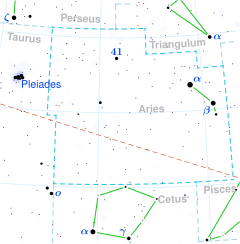Rho2 Arietis
Appearance
| Observation data Epoch J2000.0 Equinox J2000.0 (ICRS) | |
|---|---|
| Constellation | Aries |
| Right ascension | 02h 55m 48.49800s[1] |
| Declination | +18° 19′ 53.9029″[1] |
| Apparent magnitude (V) | 5.93[2] (5.45–6.01)[3] |
| Characteristics | |
| Spectral type | M6 III[4] |
| U−B color index | +1.12[2] |
| B−V color index | +1.51[2] |
| R−I color index | 2.17[5] |
| Variable type | SRb[3] |
| Astrometry | |
| Radial velocity (Rv) | +46.0[6] km/s |
| Proper motion (μ) | RA: −7.78[1] mas/yr Dec.: −14.98[1] mas/yr |
| Parallax (π) | 9.28 ± 0.30 mas[1] |
| Distance | 350 ± 10 ly (108 ± 3 pc) |
| Absolute magnitude (MV) | +0.60[7] |
| Details | |
| Mass | 1.14±0.2[8] M☉ |
| Luminosity | 1,995[9] L☉ |
| Surface gravity (log g) | 0.30[10] cgs |
| Temperature | 3,341[8] K |
| Metallicity [Fe/H] | –0.24[10] dex |
| Other designations | |
| Database references | |
| SIMBAD | data |
Rho2 Arietis is an M-type red giant star in the northern constellation of Aries. With an annual parallax shift of 9.28 mas,[1] it is approximately 350 light-years (110 parsecs) distant from the Earth.

Rho2 Arietis is classified as a semiregular variable star with periods of 49.9 and 54.8 days.[12] It varies in visual magnitude between 5.45 and 6.01. It has the variable star designation, RZ Arietis.[3] It is generally considered to be an asymptotic giant branch star, having exhausted its core helium.[13] Based on comparison of its current temperature and luminosity with theoretical evolutionary tracks, its initial mass is estimated to have been 1.3 M☉ and its mass now is 1.14 M☉.[8]
References
- ^ a b c d e f van Leeuwen, F. (November 2007), "Validation of the new Hipparcos reduction", Astronomy and Astrophysics, 474 (2): 653–664, arXiv:0708.1752, Bibcode:2007A&A...474..653V, doi:10.1051/0004-6361:20078357, S2CID 18759600.
- ^ a b c Lee, T. A. (October 1970), "Photometry of high-luminosity M-type stars", Astrophysical Journal, 162: 217, Bibcode:1970ApJ...162..217L, doi:10.1086/150648.
- ^ a b c V* RZ Ari, entry, Combined General Catalog of Variable Stars (GCVS4.2, 2004 Ed.), N. N. Samus, O. V. Durlevich, et al., CDS ID II/250.
- ^ Morgan, W. W.; Keenan, P. C. (1973), "Spectral Classification", Annual Review of Astronomy and Astrophysics, 11: 29, Bibcode:1973ARA&A..11...29M, doi:10.1146/annurev.aa.11.090173.000333.
- ^ HR 867, entry, Bright Star Catalogue, 5th Revised Ed., D. Hoffleit and W. H. Warren, Jr., 1991, CDS ID V/50.
- ^ Famaey, B.; et al. (January 2005), "Local kinematics of K and M giants from CORAVEL/Hipparcos/Tycho-2 data. Revisiting the concept of superclusters", Astronomy and Astrophysics, 430 (1): 165–186, arXiv:astro-ph/0409579, Bibcode:2005A&A...430..165F, doi:10.1051/0004-6361:20041272, S2CID 17804304.
- ^ Anderson, E.; Francis, Ch. (2012), "XHIP: An extended hipparcos compilation", Astronomy Letters, 38 (5): 331, arXiv:1108.4971, Bibcode:2012AstL...38..331A, doi:10.1134/S1063773712050015, S2CID 119257644.
- ^ a b c Halabi, Ghina M.; Eid, Mounib El (2015). "Exploring masses and CNO surface abundances of red giant stars". Monthly Notices of the Royal Astronomical Society. 451 (3): 2957. arXiv:1507.01517. Bibcode:2015MNRAS.451.2957H. doi:10.1093/mnras/stv1141. S2CID 118707332.
{{cite journal}}: CS1 maint: unflagged free DOI (link) - ^ Tsuji, T. (2008). "Cool luminous stars: The hybrid nature of their infrared spectra". Astronomy and Astrophysics. 489 (3): 1271–1289. arXiv:0807.4387. Bibcode:2008A&A...489.1271T. doi:10.1051/0004-6361:200809869. S2CID 19007399.
- ^ a b Prugniel, Ph.; Vauglin, I.; Koleva, M. (July 2011), "The atmospheric parameters and spectral interpolator for the MILES stars", Astronomy & Astrophysics, 531: A165, arXiv:1104.4952, Bibcode:2011A&A...531A.165P, doi:10.1051/0004-6361/201116769, S2CID 54940439.
- ^ "RZ Ari -- Semi-regular pulsating Star", SIMBAD Astronomical Database, Centre de Données astronomiques de Strasbourg, retrieved 2012-08-08.
- ^ a b Tabur, V.; et al. (December 2009), "Long-term photometry and periods for 261 nearby pulsating M giants", Monthly Notices of the Royal Astronomical Society, 400 (4): 1945–1961, arXiv:0908.3228, Bibcode:2009MNRAS.400.1945T, doi:10.1111/j.1365-2966.2009.15588.x, S2CID 15358380.
{{citation}}: CS1 maint: unflagged free DOI (link) - ^ Eggen, Olin J. (1992). "Asymptotic Giant Branch Stars Near the Sun". The Astronomical Journal. 104: 275. Bibcode:1992AJ....104..275E. doi:10.1086/116239.

